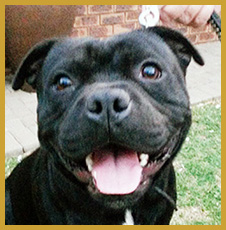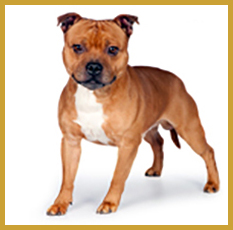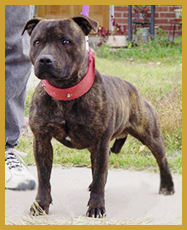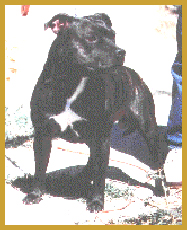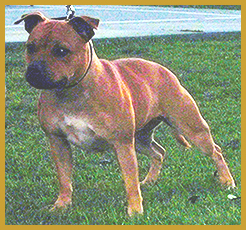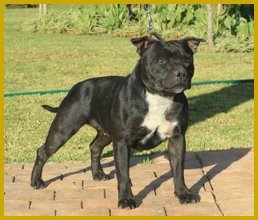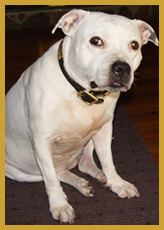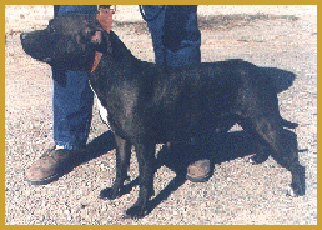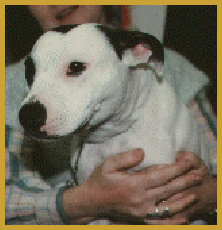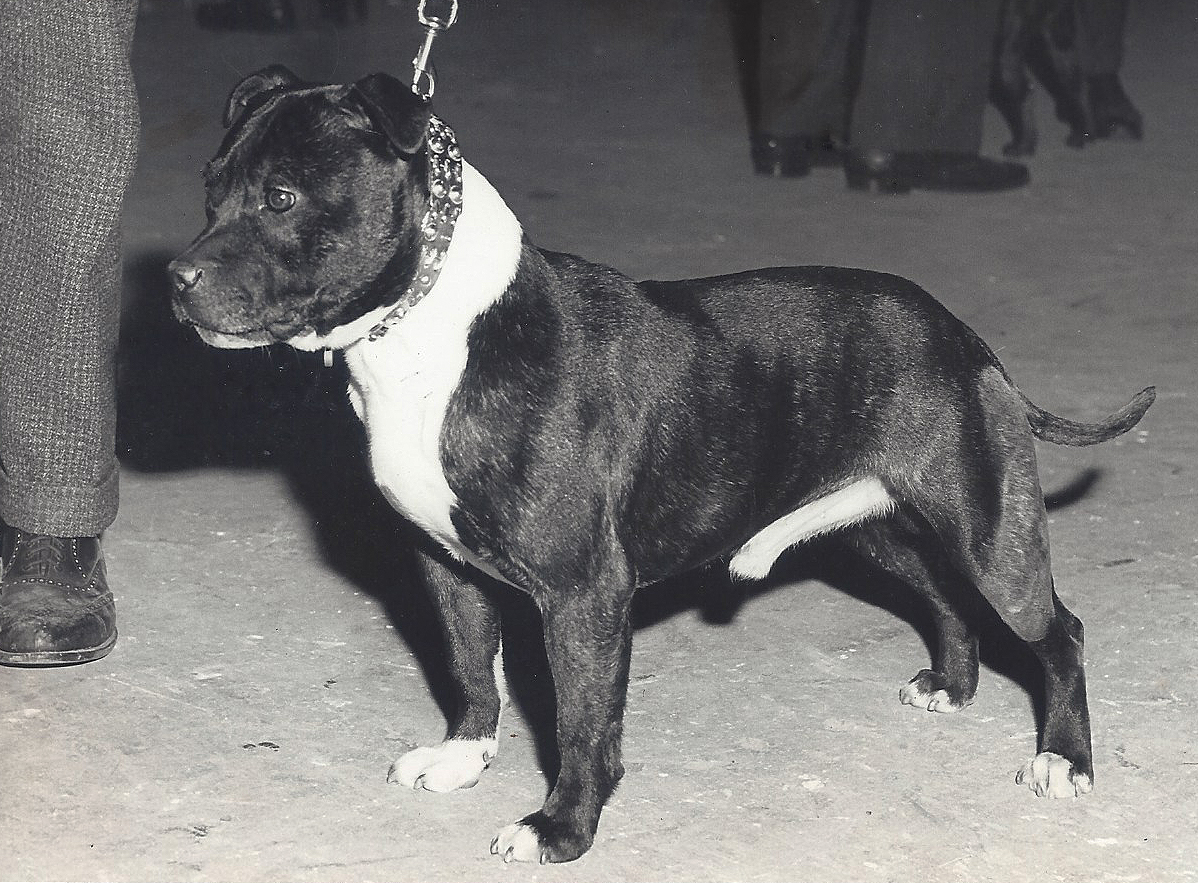Article 4
To: All Stafford enthusiasts. Subject: Last Year's (1997) Crufts (Long - bring your lunch!).
It was suggested to me that some of you might like to see the Crufts Report that I wrote last year. For those of you with the historical turn of mind, read on.
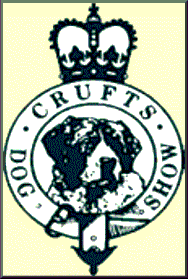 Just returned from an unforgettable seven days in England, terminating at Crufts on Thursday, March 6, then flying to Odessa, TX, all day Friday, driving home to Cloudcroft, New Mexico, on Saturday, and writing this in the wee small hours of Sunday morning due to jet lag - or leprechauns.
Just returned from an unforgettable seven days in England, terminating at Crufts on Thursday, March 6, then flying to Odessa, TX, all day Friday, driving home to Cloudcroft, New Mexico, on Saturday, and writing this in the wee small hours of Sunday morning due to jet lag - or leprechauns.
Warning #1 : If you're looking for show results or a recap of the big winners and/or owners. you'll not find them here. My interest lies in the process rather than the results.
Warning #2 : Everything herein consists not of facts but of impressions from this year's Crufts as compared with those from 1965 and 1966 Crufts, overlooking everything in between. Memory is a tricky thing, and the eye is fallible.
Warning #3 : Differences exist between an American dog show and English dog show. I would describe Westminster as a dog SHOW and Crufts as a DOG show.
Warning #4 : Although 205 Staffords were entered, one has to keep in mind that while they could probably be considered typical of the best Staffords currently being shown in the UK, they should not be considered typical of the British bloodstock because there (as in other countries) the vast majority of dogs are never ever shown - for a variety of reasons.
General impressions:
#1 - Overall, the Staffords I saw formed a decidedly positive composite. I had half expected to see a number of outsized and/or overdone exhibits. This failed to be the case as only a few seemed to exceed a guesstimated 16 inches. I also half expected to see a number of obese Staffords, and this presentiment was realized at least in part. I further half expected to see a number of exhibits that were not in iron-hard condition, and this expectation was met in full as none of the dogs I actually handled (perhaps twenty) came even close to that description whereas at 1966 Crufts probably 80% did. This is a correctable state of affairs, however, and certainly accounts for much of the disparity between photos taken of Staffords back then and photos taken now. (Most American fanciers derive a visual perception of British Staffords via photographs taken of winners.) It also explains why many Staffords of 16 inches and less would have failed the 38/34-pound limit, had they been weighed. I had also half expected to see a number of exhibits carrying "bulldog bone" rather than "terrier bone" but encountered not a one fitting into that category.
#2 - Breed type has become much more uniform, making the job of evaluating classes more difficult. A great deal of Breed uniformity in type has been attained, exactly what many Stafford enthusiasts were strongly advocating in the Sixties. From the short-range viewpoint this can be considered a positive development. From the long-range viewpoint, this can be interpreted negatively in that the Breed has lost a degree of its genetic diversity. (Can anyone find a genuine outcross?)
#3 - I was delighted to see a larger percentage of women handling Staffords in the ring although men still outnumber them. Also I was delighted to see a large number of working-class men, especially, young working-class men, owning and handling Staffords and doing a good job of it at that. The Stafford has always been a working-class man's dog, and it was a delight to see that this aspect of the Breed hasn't changed much in England. As far as I could tell, professional handlers were conspicuous by their absence from the Stafford ring so that owners/breeders continue to maintain control.
#4 - The Crufts stats are staggering! Birmingham Exhibition Center is enormous. Staffords appeared in Hall 1, Rings 2 and 3, but getting there seemed like a cross between Australian Rules Football and the Iditerod. The show runs four days to accommodate the 19000+ exhibits (and exhibitors). I never did see the head-count of spectators, but it seemed as though Friday, Terrier and Hound Day, hosted the entire University of Nebraska football stadium crowd. Stafford dogs were judged in a huge ring by G. Westwood and Stafford bitches in the adjoining ring by G. Walton. Many classes boasted more than 20 exhibits so that the crowd (very friendly, quite knowledgeable) stood three and four and five deep around each large ring. It was difficult, nearly impossible, to navigate due to the crush. Everyone seemed to be having a grand, carefree time as evidenced by the fact that exhibitors fearlessly left their belongings (and their dogs) unattended while they kibitzed.
Specific impressions:
#1 - Breed type has changed somewhat in the head and skull, probably due to the genetic influence several outstanding winners over the last couple of decades. On average, the skull has broadened a bit and the muzzle has become slightly shorter (in a few cases, possibly a less than the "standard" 1:2 ratio), so that the entire head when viewed from above forms a "V." But the most visible change is that the muzzle when viewed in profile now tilts upward several degrees more than it used to. In addition, the eyes have become more prominent. As a consequence, the dog now has an expression that differs marginally from his ancestors'. While not at all negative in its cumulative effect, this phenomenon should also be viewed as a red warning flag: if the skull continues to broaden, whelping problems will inevitably follow; and if the muzzle continues to shorten - well, you fill that one in with your own phrase.
#2 - In the show ring, exhibitors seem to have discontinued the use of the two-inch Stafford collar-on-a-collar in favor of an inch-wide single-layer black collar decorated with brass pieces. No choke chains or wimpy nylon straps, thank goodness. (One of my many pet prejudices.)
#3 - The trend in coat color has changed. I saw a much higher percentage of unmarked black brindles and much lower percentage of tiger or mahogany brindles, perhaps only three or four; a smaller percentage of reds. Of the reds in attendance, there was a much higher percentage of red smuts but a much smaller percentage of fawns. Saw two blues, something of a novelty, and one exhibit that seemed to be blue-gray - but it may have been the lighting which made that effect. I was somewhat surprised at the number of all-whites (head patches and tail patches not counted) and the number of pieds but truly astonished at the number of skewbalds (also called red pieds) which used to be a rarity.
#4 - Stafford aggressiveness in the ring is somewhat diminished, most of it seeming to consist of the "get off my back" variety instead of dedicated "I'll have your guts for garters" sort, and the owner-handlers took it in stride. However, Stafford "yappiness" has increased. At 1966 Crufts one hardly ever heard any barking, but at 1997 Crufts one clearly understood that one was amongst yapping terriers. Chalk this up as another prejudice if you will, but I prefer Staffords to be silent as snakes.
#5 - Each gender was divided into nine "competitive" classes (Special Puppy, Special Junior, Special Yearling, Undergraduate, Graduate, Post Graduate, Mid Limit, Limit, and Open) and one "non-competitive" class (Special Veteran). Open Dog had an entry of 33 dogs, 10 of which were already Champions in their own right. Open bitch had 25 entries, nine of which were Champions in their own right. Three CC's are needed for an exhibit to become a Champion of Record, so for a non-champion Stafford to receive the CC at Crufts he/she had to win out over all existing champions in his/her class (ten or nine, respectively), no easy task. (The results are available via http://easyweb.easynet.co.uk/~nickwheat/staffy.html, if you just have to know.)
#6 - For the most part, I looked at the Staffords themselves rather than classes but made an exception for the Limit class, the one just before the Open class. My theory has always been that if a Stafford is a good enough show dog to place first, second, or third in the Limit class at a Championship show, he/she will easily make into an American Champion. The Limit dog class had 23 entries and the Limit bitch class 25 entries, so the judges had their work cut out for them. As a spectator, I would guesstimate that about fifteen of the dogs and thirteen of the bitches could be made into American champions in a couple of weekends by anyone who knew what he/she was doing. As for the next five or six exhibits, it would depend on circumstances but perseverance would probably get the job done. If you think I am trying to say that the overall quality was extremely high, you've got the message.
#7 - Almost all benched dogs were confined in wire crates (probably to protect them from the crowds rather than visa versa), a radical departure from previous practice when they were kept in the crate by a short strap attached to the collar. The modern practice makes it difficult to see the dogs as they are mostly lying down while behind bars, looking miserable or yapping miserably, but it does allow the owners to leave them unattended. This may or may not be the reason I observed a much higher percentage of Staffords in the ring who could only be described as unhappy campers, exhibits with tails between their legs, heads down, ears laid back, eyes rolling.
#8 - I had half expected to see a number of dogs with "iffy" movement, and there were a few, but only a few. Rear movement on the whole has improved (some needed to display more drive from the hindquarters) while front movement is marginally better. These comments, of course, apply only to the happy campers.
#9 - As I knelt by the ring hoping to get photographs, I was attacked by five for six Staffords who attempted to smother me with kisses. From what I was able to determine under such limited circumstances, the genuine Stafford temperament is alive and well in the U.K.
#10 - I gleefully noticed the total absence of winning ribbons attached to bench stalls. American showpeople seem to believe: "If you've got it, flaunt it." The English attitude (which I prefer) seems to be: "If you've really got it, you don't need to flaunt it." Different horses for different courses. I genuinely regret not getting to meet the Nick Wheat's, the Mervyn Thomas's, and the David Ormes's due to my having to depart for England before the rendezvous spot and hour had been set, and, once there, having no way of finding it out. On the other hand, this unfortunate circumstances simply gives me an additional reason to visit Merrie England one more time.
Tidbits:
From what I could see, the qualify of white and color Bull Terriers has regressed somewhat since the days of the late Raymond Oppenheimer, but the quality of the Miniature Bull Terriers has improved considerably. Border Terriers seem stronger there than here. I was delighted to see that the Finnspitz numbers and quality are vastly improved.
No American Staffanatic should miss the Crufts experience!
Steve Stone
And then, a few days later, an addendum:
Perhaps an addendum to my previous post on Crufts might not come amiss at this point. I did not post the following previously because I wanted to make sure my thoughts were in order before doing so and that I would choose my words carefully.
All the caveats of my previous post still apply.
I need to say something about the phenotype - the overall appearance - of the bitches I saw at Crufts this year. The bitches were much more even in size and type than before. Gone were the slender damsels, vanished were the macho gals, departed were the Plain Janes. Had they all been of one color, say, black brindle, the casual spectator like myself would have been hard pressed to tell one from another, which wasn't at all the case in earlier days.
From a show perspective, this has got to be considered a major plus.
I had half expected to see a number of outsized bitches, a few undersized bitches, and too many overdone or doggy bitches. Happily, this was not the case although - like the dogs - none that I actually handled were in iron-hard condition. This again has to be considered a major plus.
That said, what I did see caused me to pause and consider - and consider and consider and consider. (Which is why I waited to make this post.)
What I saw - overall - was a group of bitches that constituted a somewhat feminized version of the dogs in the other ring. Not particularly smaller on average, but a bit more slender, a bit less bulky, and bit less masculine. BUT not particularly feminine, perhaps lacking that definitive gender stamp that once existed.
I have difficulty convincing myself that this development is a good thing.
Steve Stone
Subject: 1997 Crufts Photos
Am attaching nine scanned photos at 1997 Crufts. I took many more, but my ASA 400 film was too slow for successful non-flash photos.
As you see, mostly I photographed the bitches, not only because the light was better on that side of the hall but because I believe that bitches are the future of the Breed.
For the record, I was so busy observing that I didn't concentrate properly on taking good candid shots. I don't much care for posed winners photos and made no attempt to take any.
The photos:
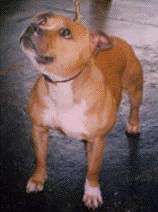
1. A nice fawn dog standing on the sidelines, not terribly happily. Fawn are much rarer now than formerly.
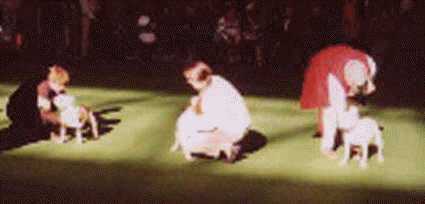
2. A bitch class, possibly Open Bitch. The three bitches at the left (placing first, second, and third) are whites or pieds, rare or at least unusual in the Sixties. Interestingly, in one of the previously classes (Mid Limit or Limit) the top three were all unmarked black-brindles.
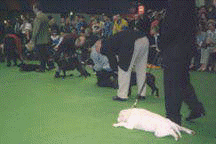
3. My favorite of all the photos: showing a white Stafford and his Border Terrier buddy getting away from it all. Who's taking care of whom?

4. Same class, different view.
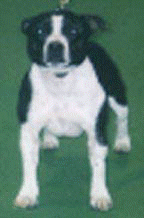
5. The head of a nice red dog in the ring. This accidental shot shows the slight upward tilt of the muzzle that I mentioned in a previous post.
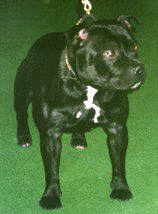
6. A good-looking black-brindle dog, one of the finalists in (I believe) the Limit Dog class. Strongly reminiscent of (Ch.) Rapparee Renegade as a youngster in the 1966 Crufts Limit Dog class.
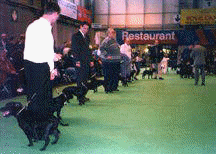
7. Same class, different view.
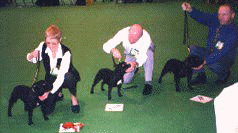
8. Can you say, "Relaxed owner-handler," children? The accidentally-by-photography beheaded person on the other end of the leash connected to this white (pied) entry (finalist?) in the Open Dog class displays a rather typically English nonchalant panache in the ring, confident in his perfect perfect control over his Stafford who seems quietly ready for all comers.
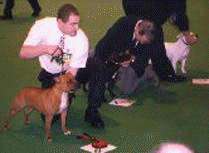
9. Head shot from above of another nice red dog which (if memory serves) had won two Reserve CC's prior to Crufts. The V-shape of the head and muzzle shows nicely in this photo.
